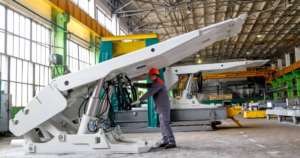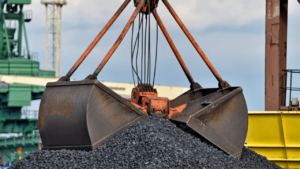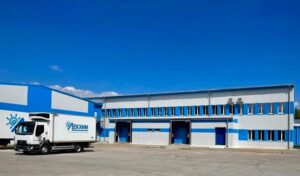
Corum Druzhkivka Machine-Building Plant (Corum DrMZ), part of the Corum Group (DTEK Energy), has manufactured its first support beam, which serves as a support for the mine’s lifting vessel (skip or cage) during scheduled maintenance or repair work, the plant announced on Facebook.
“This is not a serial product or a borrowed solution. The machine builders developed a new type of equipment from scratch, created the design, worked out the technical solutions, and patented them as a utility model. For the company, this is a new product and the result of its own engineering development,” the statement said.
The design is rated for significant loads — up to 60 tons in normal operation and up to 80 tons at maximum, which is important for human safety.
The plant explains that during the work, the beam will temporarily hold the skip in the cross-section of the mine shaft. Built-in hydraulic jacks will allow the vessel to be lifted above the beam structure, creating safe conditions for servicing suspended devices or ropes.
“The beam is not a permanent piece of equipment, but its use will increase safety during routine maintenance and repair work. Currently, the beam is manufactured for use in one of DTEK Energy’s mines, but the mine potentially needs three more support beams — one of the same size and two of a different design,” the company said.
Once its effectiveness has been confirmed, the solution has the potential to be rolled out to other mines.
Korum DrMZ, which relocated from Druzhkivka (Donetsk region) to Dnipro in 2022, in January-September this year, according to YouControl, incurred losses of almost UAH 90 million, compared to a net profit of UAH 4.6 million for the same period last year and slightly lower net sales revenue of UAH 844.6 million.
In January-October, the plant manufactured 336 units of mining equipment, repaired 12 units of equipment, and produced over 821,000 parts.
Corum Group is a leading manufacturer of mining equipment in Ukraine. It is part of DTEK Energy, an operating company responsible for coal mining and coal-fired power generation within Rinat Akhmetov’s DTEK energy holding.

Portugal officially collects and publishes statistics on real estate transactions involving foreign buyers, but the publicly available data is usually aggregated by group (Portuguese buyers, EU residents, non-residents/non-EU), without a detailed breakdown by nationality. Detailed rankings of buyer countries are usually provided by specialized analytical companies and media based on real estate network databases.
According to data from the Portuguese National Statistics Institute (INE), in 2023, foreigners accounted for about 7.6% of all home purchases in the country, but provided approximately 13% of the total value of transactions. At the same time, buyers from non-EU countries pay an average of around €405,000 per property, while foreigners from the EU pay around €277,000, and the average market price is around €200,000.
In some regions, the proportion of foreigners is much higher. In the Algarve, they account for about 27% of all transactions and up to 38% of the total sales value, with 4 out of 5 properties there being purchased by non-residents. In cities, primarily Lisbon and Porto, the share of foreign transactions is smaller, at around 4-6%, but it is in the capital that the most expensive purchases are concentrated.
Private analysts provide a detailed picture by nationality. In Lisbon, according to Confidencial Imobiliário, 4,750 apartments and houses worth €2.22 billion were sold in the Urban Rehabilitation Area in 2023, of which 1,580 properties (about a third) were bought by foreigners. Buyers from North America led the way (approximately 16% of all “foreign” transactions), followed by the French (13%) and the British (9%). Chinese, Brazilian, and German investors also had a significant presence.
In the Algarve, according to estimates by Engel & Völkers, British buyers predominate, but there is also an active presence of citizens from Germany, France, Sweden, Switzerland, and the Netherlands; interest from Americans is growing noticeably.
Based on this data and market reviews, we can identify a conditional “top 10” of the most active foreign buyers of Portuguese real estate (by number of transactions and total investment volume):
Investors under the previous “golden visa” scheme (primarily from China, Brazil, Turkey, the US, and South Africa) are listed separately, but following the reform of the program, their share is gradually being redistributed in favor of “regular” transactions.
Thus, Portugal publishes official data on the share and prices of transactions with foreigners, but a detailed map by nationality is based mainly on research by specialized agencies and market analysts. Taken together, they show that demand is primarily driven by investors from Western Europe, North America, and Brazil, while the role of buyers from Eastern Europe and the CIS remains niche.

Global seaborne thermal coal exports in 2025 fell for the first time since 2020, by 5% to a three-year low of 945 million tons, Reuters reports, citing data from Kpler.
The main reason for the decline was a reduction in imports by Asian countries.
Since the beginning of the year, they have imported 841 million tons of thermal coal, which is 7% less than the figure for the whole of 2024.
China was the largest importer (305 million tons), followed by India (157 million tons), Japan (100 million tons), South Korea (76 million tons), and Vietnam (45 million tons).
At the same time, only South Korea and Vietnam increased their volumes. China reduced imports by 12%, India by 3%, which in both cases is explained by an increase in domestic coal production and consumption of other energy sources.

PJSC Lekhim-Kharkiv (Kharkiv) will hold an extraordinary general meeting of shareholders remotely by means of a poll, according to a statement from the company.
According to the document, voting began on December 12 at 11:00 a.m. and will end on December 23 at 6:00 p.m., which is also the date set for the meeting (the date of the end of voting).
The draft agenda includes issues on the termination of the powers of the members of the supervisory board, the election of a new supervisory board (cumulative voting), and the approval of the terms of civil law contracts with the members of the supervisory board. In particular, the company proposes to terminate the powers of the head of the supervisory board, Valery Pechaev, and members of the supervisory board, Valentina Mazurik and Angela Nikitina. It is also proposed to define the agreements with the members of the supervisory board as gratuitous and to authorize the chairman of the management board, Dmitry Kolesnikov, to sign them on behalf of the company within one month from the date of the decision.
PrJSC Lekhim-Kharkiv (EGRPOU code 22676945) is registered in Kharkiv, at 36 Severina Pototskogo Street. The main shareholder is PrJSC Lekhim, which owns 98.17673% of the company’s shares (according to the ownership structure as of May 22, 2025).
According to the IFRS financial statements, in 2024, the company received net sales revenue of UAH 766.2 million and net profit of UAH 32.7 million; assets as of December 31, 2024 amounted to UAH 864.2 million, and equity capital amounted to UAH 671.8 million. The average number of employees in 2024 was 416.

The US has proposed a meeting between the national security advisors (NSA) of Ukraine, the US, and Russia, Ukrainian President Volodymyr Zelenskyy said, expressing cautious optimism about the prospects for such a meeting.
“As for Umerov (Secretary of the National Security and Defense Council Rustem Umerov, who is in the US, where he held talks with American and European partners on ending the war), he called me and said that America is now proposing a trilateral meeting of the NSA – America, Ukraine, Russia,” Zelensky said in comments to reporters on Saturday.
The president noted that he is not sure that this meeting will bring anything new, but pointed out that a similar meeting in Turkey resulted in the return of captured military personnel and civilians, so it is worth holding such meetings.
“I believe that this is not everything we wanted, but it is very important. I am very glad that we had exchanges. Our people, our military personnel, especially prisoners, have returned home. And civilians too. And that is why such steps must be taken. And if there can now be a meeting that will unblock the exchanges, or if the result of the trilateral NSA meeting could be an agreement on a trilateral meeting of leaders, and I have said this many times, there are complex issues that must be resolved by the leaders of the states. Therefore, if the results are exchanges or some other agreements, I cannot be against it, we will then support the proposal of the United States of America. Let’s see how it goes,” Zelensky said.

According to Serbian Economist, the first international Nikola Tesla Film Festival, dedicated to the life and legacy of Serbian-American inventor Nikola Tesla, will be held on January 7, 2026, in Las Vegas (USA) at the Palms Casino Resort.
According to the festival organizers, the goal of the event is to use film to show Tesla’s lasting influence on modern civilization—from electric power to wireless communications—while strengthening the cultural bridge between Serbia and the US.
According to their data, 120 applications have already been submitted from around the world, including the USA, Canada, Japan, India, European countries, Ukraine, Latin America, and Africa.
The program will include feature films and documentaries that explore the themes of science, innovation, and “visions of the future.” In addition to screenings, there will be cash prizes and a special prize—a Tesla statuette—as well as a separate award for projects created using artificial intelligence technologies, which, according to the organizers, will set a precedent for the US festival landscape.
The festival remains open to international submissions, with participation free for students to encourage young filmmakers to explore scientific and technological themes and the legacy of Nikola Tesla.
https://t.me/relocationrs/1972